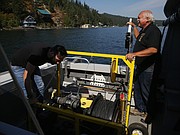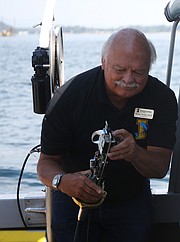Trial by water
By DEVIN WEEKS
Staff Writer
COEUR d’ALENE — Research testing doesn't always go as planned, as demonstrated Thursday morning during a University of Idaho-Coeur d'Alene test dive.
"It wasn’t anything to do with the submarine as much as it was just one little component that had apparently been slowly filling up with water,” said graduate researcher Adrian Beehner. "That’s the tough thing when you’re doing that type of water research. Water’s so tough to work around."
Beehner and undergraduate researcher Sam Freitas have spent more than 1,000 hours working to program artificial intelligence into the submersible drone "Catfish" to allow the device to scan the bottoms of bodies of water and collect information from its environment.
“The Catfish is one of our major programs," said John Shovic, clinical faculty associate professor for the University of Idaho-Coeur d’Alene College of Engineering. "It really is very tied into the community here because of the lake, the lake quality, the mapping, the elevation, the models and everything. It’s really understanding the ecosystem in the lower part of the lake."
The student researchers and their crew boated to Stevens Point to send Catfish to the floor of Lake Coeur d'Alene to begin tests on autonomous software.
"This is a research dive," Shovic said. "Things may go wrong,"
As the team members prepared the drone, they realized water had crept into the communications module from previous test dives, meaning Catfish wouldn't be able to send back information.
"When you’re in water, there’s just so many more variables you have to account for, and I think that’s something that is a learning process," Beehner said. "The idea that the communications module could get a tiny bit of water in it, that’s something I wouldn’t have probably anticipated beforehand."
The team did test the winch system and lower the drone for a few minutes, but then returned to shore knowing what to do for next time.
"It was a process figuring out what was actually happening," Freitas said. "It was kind of a bummer to find out one of our supposedly waterproof modules was not waterproof. It was a learning experience, so we’ll fix it and then we’ll be good to go."
"Always with research, you're going to run into the little kinks, but the overall experience, even today, I’m going to look at it positively," Beehner said. "I'm really excited to see where it moves forward from here and where we can make it better."
Catfish was originally designed by Gizmo-CDA, from which University of Idaho purchased it for $10,000, Shovic said. He said this kind of drone, which is being modified into a science drone, could easily be valued at $50,000.
Once the drone passes more tests and is equipped with a sensor pod this fall, it will be testing oxygen and temperature levels, water clarity and recording video of the mysterious lake bed. Shovic said Catfish should be fully autonomous and making sweeps next summer.
"I think there will be a lot of applications for it," Freitas said. "Nobody really knows what’s going on on the bottom. I think it will open up a lot of new avenues for people."









